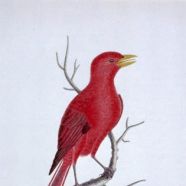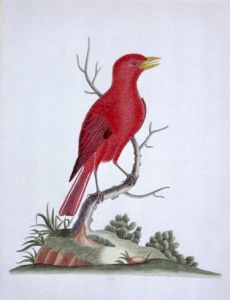
John Abbot, Summer Red Bird (no title), ca. 1790, watercolor on paper, 16 ¼ × 12 ¼ inches; Plate H: 11 ¼ × 8 ¾ inches. Art Museums of Colonial Williamsburg, Museum Purchase, 1981–38.
Share This
Print This
Email This
Different Feathers: Reflections on John Abbot’s Summer Red Bird
When imagining the varied collections at the Art Museums of Colonial Williamsburg, John Abbot’s late eighteenth-century watercolor Summer Red Bird is not necessarily the first piece to come to mind. Partly this is because as a work on paper it simply doesn’t get viewed as often as other, less light-sensitive works.[1] It’s also a different kind of object from many of the animal-related holdings within the collection. It does not evoke the whimsy of the folk art in the Abby Aldrich Rockefeller collection, for instance, whether it’s the carousel figures, the trade signs associated with different commercial ventures, or seemingly unique sculptures such as Edgar Alexander McKillop’s bizarre Hippoceros record player. Although it is contemporaneous with many of the decorative arts affiliated with the DeWitt Wallace collection, its purpose suggests a different kind of consumption, one associated with the leisured study of natural history and the documentation of specimens rather than turtle soup or tea. Yet Summer Red Bird nevertheless encapsulates the collection’s multifaceted histories and geographies. As a scientific illustration, it is both decidedly Southern and international in its geography, its red bird in dialogue with both the eighteenth century and the present regarding migrations, climate change, and fluctuating ecologies.

John Abbot, Summer Red Bird (no title), ca. 1790, watercolor on paper, 16 ¼ × 12 ¼ inches; Plate H: 11 ¼ × 8 ¾ inches. Art Museums of Colonial Williamsburg, Museum Purchase, 1981–38.
Painted around 1790, the subject of Summer Red Bird is a male Summer Tanager; information about its appearance and behavior can be found easily online or in printed bird guides. Like many bird species, the plumage is sexually dimorphic, with the male assuming a vibrant, almost vermilion shade of red, and the female a more muted yellow. Summer Tanagers spend the winters in Central and South America, its range spanning from central Mexico to Bolivia and Brazil. During the summer breeding season, it ventures into the southern United States, including the Southeast.[2]
It is, in short, a bird that John Abbot (1751–ca. 1840) would have seen while living in eighteenth-century Georgia. Born in London in 1751, Abbot initially served as a clerk to his father, a lawyer, before deciding to pursue the study of art and natural history. Biographers state that he studied with Jacob Bonneau, an engraver who also appears to have worked in watercolor. Abbot is arguably best known for his meticulous illustrations of butterflies, moths, and other insects, having first exhibited a selection of Lepidoptera at the London Society of Artists in 1770. Through that exhibition, Abbot was introduced to Dru Drury and other leading collectors of the time. In 1773, he ventured across the Atlantic to collect specimens in Virginia but relocated to Georgia two years later to avoid the impending conflict of the Revolution. He didn’t avoid the war, but he nevertheless established himself permanently in Georgia, frequenting the area around Savannah.[3]
Abbot’s oeuvre underscores the intellectual and commercial networks shared between Europe and the United States regarding the study of natural history, and the ways the natural world shaped intellectual and commercial discourse. While Abbot’s illustrations may have highlighted the flora and fauna of Georgia, for instance, his engagement with natural history through both his illustrations and his original specimens kept him connected with Europe. As a supplier, he collected specimens primarily for European collectors, with London-based jeweler and insect collector John Francillon acting as his agent and distributor. Abbot became particularly renowned for his ability to pack delicate butterflies and other insects and ship them across the Atlantic intact.[4] As an illustrator, Abbot’s work appeared in such publications as James Edward Smith’s 1797 The Rarer Lepidopterous Insects of Georgia, which featured illustrations based on Abbot’s drawings. In 1816, artist-naturalist William Swainson commissioned Abbot to produce a set of illustrations for a proposed sequel to The Rarer Lepidopterous Insects of Georgia, though this would never come to fruition. Unlike John James Audubon, who both wrote and illustrated The Birds of North America, Abbot did not regard himself as an author, preferring to supply materials for other naturalists instead.[5]
Although Abbot’s insect illustrations remain his most highly regarded work, both during his lifetime and today, he also created numerous watercolors of birds, as Summer Red Bird attests. The actual sheet measures 16 ¼ × 12 ¼ inches, while the illustration’s measurements span 11 ¼ × 8 ¾ inches.[6] In other words, the bird in question is shown at approximately life size, giving viewers a direct visual example of its scale. The number 34 appears at the bottom of the sheet; its exact purpose remains unknown. According to Janice Neri, Abbot created numbered templates that clients could then choose from when sending orders, though whether this drawing is an example of a template piece or was intended for a separate project is unclear.[7]
As an illustration, Summer Red Bird presents a male Summer Tanager in seeming isolation. Whereas Audubon’s depiction of the Summer Tanager in his Birds of North America would show three birds, two males and a female, perched in various positions within a berry bush, Abbot’s rendering presents a single bird.[8] It perches on a branch surrounded by stylized grass and vegetation. The grassy mound is tiered, giving the impression of a small cliff face, while the branch appears to be devoid of leaves. The bird itself has been rendered with meticulous detail, with each feather of its plumage carefully delineated. The illustration also suggests an aural quality, as Abbot has appeared to capture the bird in mid-song, its beak open and its tongue visible between its two bills. Though likely unintended, this silenced birdsong, combined with the barren state of the bird’s perch, seems to emphasize its isolation. This tanager may be singing, but it appears to be devoid of an audience outside of the viewer.
Yet the bird’s seeming isolation belies the illustration’s interconnectedness, not only to prospective European consumers but also to the enslaved labor that enabled its creation. In addition to his work as a naturalist, Abbot was connected to Georgia through his property ownership. By 1777, Abbot was living northwest of Savannah in a parish of Burke County, and in 1784 he applied for a headright grant of 200 acres, receiving it in 1789.[9] As a property owner, Abbot owned enslaved people who worked his land, labor that enabled him the freedom and mobility to travel across Georgia collecting and documenting specimens. Enslaved people also maintained the gardens, parks, and other cultivated land that Abbot visited when looking for specimens. Enslaved people also may have helped him prepare specimens and assist him with his illustrations.[10] With its plain white background and absence of human subjects, Summer Red Bird belies its connections with enslaved labor, but its existence remains intimately entangled with it. It is a Southern piece not only in its subject matter but in the labor that enabled its creation.
Yet Summer Red Bird also converses with the twenty-first century as well as the eighteenth, both through its subject matter and its changing boundaries. Abbot may have conceptualized Summer Red Bird as a scientific illustration of a Southern species, yet the Summer Tanager’s boundaries have been shifting in light of ongoing climate change. Under a 1.5 Celsius increase, the Audubon Society predicts the Summer Tanager losing ground in Florida and Mexico while venturing north into Iowa and Pennsylvania. With a three-degree increase, it could potentially become more common in New York and Massachusetts. Unlike other bird species, the Summer Tanager may not disappear, but its geographic boundaries will have changed from what Abbot would have known.[11] Yet such changes would not have been outside of Abbot’s practice. As Pamela Gilbert observes, “Abbot noted how the ponds in pine woods often became shallow holes in the summer and predicted that some birds would become rare as the country became more settled.”[12] As a naturalist, Abbot was attuned to the changes in his local environment, noting the impact of farming and other human activities on the surrounding landscape.
So perhaps Summer Red Bird isn’t so isolated after all. Rather, it’s a work that only becomes complete when a human viewer engages it. As William Cronon observed in his now-classic Nature’s Metropolis, the division between nature and culture is a fiction, with the two in actuality intertwined. Conversing with the past as well as the present, nature and culture, the South and beyond, Summer Red Bird encapsulates the complexities of both Abbot’s world and how they have changed in light of warming climates and other ecological shifts.
[1] The piece has been exhibited, most notably in the 2014 exhibition A Rich and Varied Culture: The Material World of the Early South. See “A Rich and Varied Culture: The Material World of the Early South,” Antiques & Auction News, accessed May 1, 2022, https://antiquesandauctionnews.net/articles/A+Rich+And+Varied+Culture:+%0bThe+Material+World+Of+The+Early+South/.
[2] John J. Audobon, “Summer Tanager,” Audubon Field Guide, accessed November 13, 2014, https://www.audubon.org/field-guide/bird/summer-tanager.
[3] Pamela Gilbert, John Abbot: Birds, Butterflies and Other Wonders (Art of Nature) (London: Merrell Holberton; Natural History Museum, 1998), 11–12, 48; Janice Neri et al., John Abbot and William Swainson: Art, Science, and Commerce in Nineteenth-Century Natural History Illustration (Tuscaloosa: University of Alabama Press, 2019), 4.
[4] Gilbert, John Abbot, 48; Neri et al., John Abbot and William Swainson, 4, 13.
[5] Neri et al., John Abbot and William Swainson, 4.
[6] Museum of Colonial Williamsburg, “‘Summer Red Bird’ (No Title),” Colonial Williamsburg, accessed April 19, 2022, https://emuseum.history.org/objects/29863/summer-red-bird-no-title.
[7] Neri et al., John Abbot and William Swainson, 14.
[8] John J. Audubon, “Summer Red Bird,” Birds of America, accessed November 25, 2014, https://www.audubon.org/birds-of-america/summer-red-bird.
[9] Gilbert, John Abbot, 48–50.
[10] Neri et al., John Abbot and William Swainson, 15.
[11] Audobon, “Summer Tanager.”
[12] Gilbert, John Abbot, 50.






